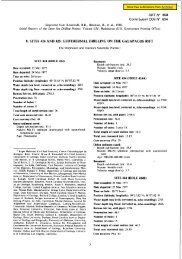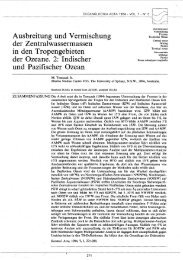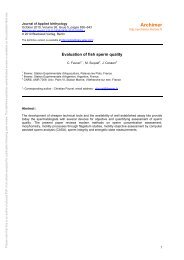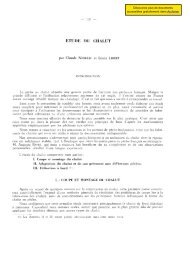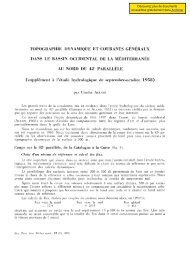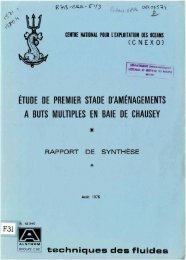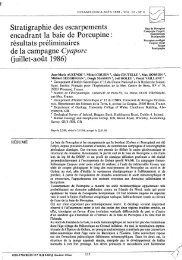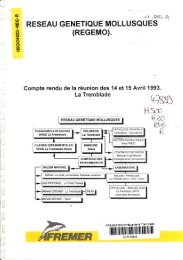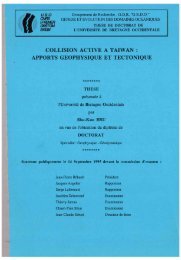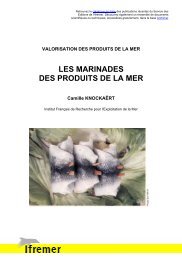Contribution à l'étude de virus de mollusques marins apparentés ...
Contribution à l'étude de virus de mollusques marins apparentés ...
Contribution à l'étude de virus de mollusques marins apparentés ...
Create successful ePaper yourself
Turn your PDF publications into a flip-book with our unique Google optimized e-Paper software.
l<br />
1<br />
1<br />
1<br />
1<br />
1<br />
1<br />
1<br />
1<br />
1<br />
1<br />
1<br />
1<br />
PUBLICATION 2<br />
Bull. Eur. Ass. Fish Pathol., 13(4), 130, 1993.<br />
LYMPHOCYSTIS OUTBREAKS IN FARMED SEA BREAM,<br />
SPARUS AURATA, FIRST REPORT ON FRENCH MEDITER<br />
RANEAN COAST<br />
Bv R. M. L E DEUFF AND T. R ENAU LT<br />
11/ 1 l'OdUCf i OIl<br />
A mong the Iridov irus related infecti ons frequently<br />
<strong>de</strong>seribed on many teleosts fi sh<br />
spccies, Viral Eryth rocytic Necrosis (VEN)<br />
(Pinto el al., 1989), Epi zootie Haematopoietic<br />
Necrosis Virus (EHNV) (Langdon<br />
el al .. 1988) as weil as Lymphocystis Discase<br />
Virus (LDV) are not consi<strong>de</strong>red to directly<br />
cause fatality. In<strong>de</strong>ed, Lymphocystis<br />
outbreaks of farmed fi sh could be observed<br />
in so rne cases. as a consequence of a bac terial<br />
double infection or cannibalism (Ahne<br />
el al .. 1991: Moate el al., 1992). Here, we<br />
re port for the first time a strong LDV infecti<br />
on, and an add ilional physical stress responsible<br />
for mortalities of reared sea<br />
brearn, Sparus aurata, From Toulon area, on<br />
French Med iterranean coas t. Although,<br />
sinee the first report oF Lymphocystis in sea<br />
bream un<strong>de</strong>r aquaculture conditions in Israel<br />
(Paperna et al .. 1982), LDVs were <strong>de</strong>seribed<br />
in other farmed sea bream in ltaly<br />
(Masoero el al. 1986), Portugal (Menezes el<br />
al. 1987). Spain (Basurco el al .. 1990), Turke<br />
y and Greece (Moate el al. 1992).<br />
Resu/fS alld dis('uss;OIl<br />
Consequent with a two days stonn, impor<br />
(an! mortalities were observed among the<br />
very infected fish, whereas faintly or not infected<br />
fi sh were not affected. Propagation of<br />
the disease and losses were further consi<strong>de</strong>rably<br />
attenuated by doubling the volume of<br />
the cages. Young sea bream (8- 10 cm long)<br />
showing a massive LDV infection at a late<br />
stage eharacterised by numerous cysts<br />
sprayed ail over the body and fins (Fig. 1)<br />
were fixed for microscopie examination.<br />
Histological sections stained with hemalun<br />
eosin revealed irregular nucleus with peripherieal<br />
packs of chromatin and basophilie<br />
4 1<br />
cytoplasmic inclusions (Fig. 2). Feulgen and<br />
Rossenbeck stai ning showed these cytoplasmic<br />
inclusions to contain DNA (Fig 3),<br />
thu s, they can be consi<strong>de</strong>red as an accumu <br />
lation of viral particles, or at (east of viral<br />
DNA. Thesc histological Icsions could be<br />
observed in <strong>de</strong>rm cells and kidney. How·<br />
ever, cytoplasmic inclusions present in ren al<br />
interstitial cells could not be <strong>de</strong>tected in re·<br />
nal tubules. Thus, nucleus in jury of these<br />
last cells could result in the proximity of<br />
LDV infected cell s. Perhaps the presence of<br />
numerous late lesions ail over the skin could<br />
also provoke a general osmoregulative<br />
breakdown resulting in disor<strong>de</strong>r of kidney<br />
cells, and thus abnormality of nucleus.<br />
Thin sections of tumors and adjacent epi·<br />
thelial ti ssue examined by transmission<br />
electron microscopy revealed electron <strong>de</strong>nse<br />
<strong>virus</strong>-li ke particlcs (fig 4), which average<br />
diameter was 2 11 nm (n = 43, range = 179<br />
to 262 nm). Icosahedric shape and cyto·<br />
plasmic location of virions in addition to the<br />
presence of DNA associated with these partieles<br />
may belong them to the Iridol'iridae<br />
family . Moreover, due ta the presence of<br />
tu mors corresponding to hypertrophied<br />
<strong>de</strong>rmal host cells together with the great<br />
size of the viral partiel es contained in these<br />
cysts and adjacent cells , they may be related<br />
to the LympllOcystis <strong>virus</strong> genus<br />
(Samalecos, 1986; Walker and Weissen·<br />
berg, 1965). We intend ta improve<br />
<strong>de</strong>scription of this isolate of LDV from sea<br />
bream noticeably by <strong>de</strong>termination of<br />
protein electrophoretic pattern of purified<br />
<strong>virus</strong>, and by antigenic characterization<br />
using monoclonal and polyclonal antibodies<br />
specifie for largemouth bass (Micropterus<br />
salmoi<strong>de</strong>s) LDV (ATCC VR-342) produced<br />
on BF2 fish cell line (ATCC CCL 91).<br />
These results may be helpful for further<br />
comparisons with other LDVs.



